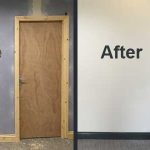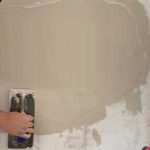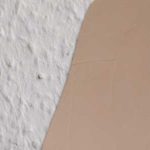Wood is a solid and firm surface, and it can sometimes be found on walls and ceilings in certain properties. However, you may want to improve your walls by skimming over with plaster, to achieve a smoother surface.
Plaster needs skimming onto a good solid subsurface, with a decent key, in order to bond and set correctly. So, will wood provide this?
The simple answer is no! Wood is not a suitable surface to skim over. It doesn’t provide the right key for plaster to bond too. This means that the plaster would likely fall away from the surface.
One reason for this, is wood absorbs moisture. This means water would be removed from the plaster, disrupting the chemical reactions that take place as it goes off. As a result, the plaster would not dry or set correctly, causing a weaker finish.

Can you skim over engineered wood?
There are several different types of engineered wood, such as ply, MDF, OSB and chipboard.
These types of wood are man made, which gives them different characteristics to solid wood. Each different type consists of a slightly different blend of materials. These can include wood fibers, sawdust, chemicals, and glue.
Generally, engineered wood comes in sheets. Therefore, you may assume it is a good surface that can be skimmed over. The surface is usually flat, with few imperfections and they tend to be durable and solid.
However, that alone doesn’t make them suitable for plastering. Plaster won’t bond well to most types of engineered woods, especially those with smooth surfaces, such as MDF.
Also, when mixing plaster, you’ll need to use a lot of water to create the right consistency. Once the plaster is applied, the water will be absorbed by the wood. Plaster dries and hardens because of a chemical reaction between the different materials. However, a change in water content, would result in the plaster being weaker and unable to dry correctly. Also, as it is soaked in, it will cause the wood to swell.
Another reason to avoid plastering over natural and engineered wood, is they can expand and contracts with changes in temperature and humidity.
When plaster dries, it becomes hard and loses all flexibility. As wood moves, this would cause the plaster to move with it, which could result in cracks, and could even cause plaster to come away from the walls.
What is the recommended solution?
Because wood is an unsuitable surface to skim over, you will need to carry out some simple prep work.
The easiest option is to plasterboard straight over the top of the wood. fixing the plasterboards will be easy as you can screw straight into the timber. This is even easier for sheets of engineered wood, as you won’t need to worry about hitting studs.
With that said, if you know there is a stud wall below the sheet, you will benefit from screwing through into the studs, where possible. This will ensure an even stronger fixing.
Once this is done, the plasterboards will then be held firmly in place, allowing you to skim over the top.
Is it ever possible to skim over wood?
The general advice is to not skim over wood, as the risk of your plaster failing is very high. If you find that you have no other option, there are some steps that you can take to reduce the chance of your plaster failing.
We should stress. It’s not recommended you use these options if you can avoid it, especially for large areas. However, they could bring success for small areas where you don’t have other options.
The first option is to use a diluted PVA solution, as this will seal the wood. Once dry, you can then apply a coat of bonding agent over the top of it. The bonding agent bonds to the PVA but will also create a key for the plaster to bond too. You can then skim over the wood.
Another option for skimming over wood, is to use expanded metal lathing (EML). This is a metal mesh that comes in a variety of sizes. It is designed to create a mechanical key and is often used in rendering over less porous surfaces. Such as rendering over engineering bricks.
The key provided by EML, will allow the plaster to bond around the mesh. To achieve the best possible finish, the mesh will need securing to the timber using galvanised screws or staples. The skim coat can then be applied over the top.
Conclusion
So, it’s clear to see that you should avoid skimming over wood where possible. Wood isn’t an ideal surface for plaster to bond too, and it can cause a range of additional problems, due to the result of movement and water absorption.
Ideally, you would remove the wood and replace with plasterboard. Alternatively, you could plasterboard over the top of the wood before skimming.
Finally, if you have no other option (which is going to be rare), you could opt to use one of the alternative options mentioned above. Although, they are not generally recommended, unless it is a last resort.




